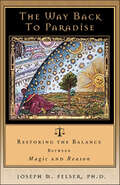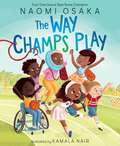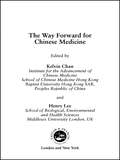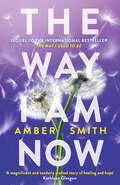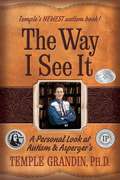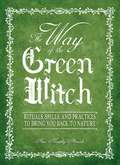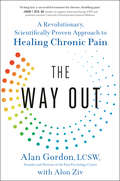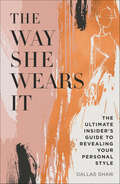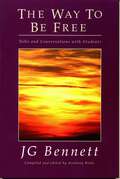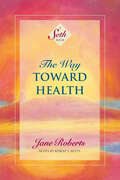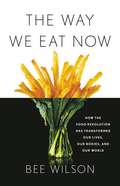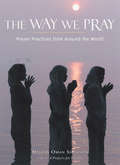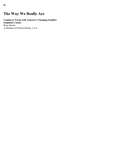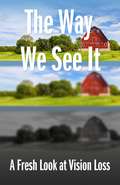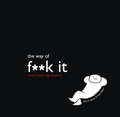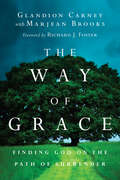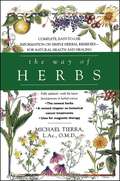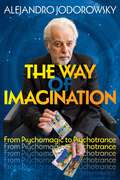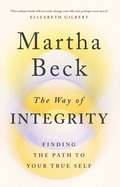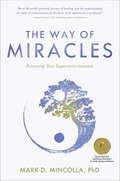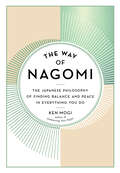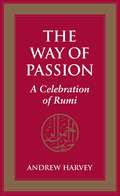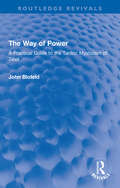- Table View
- List View
The Way Back to Paradise: Restoring the Balance between Magic and Reason
by Joseph M. FelserParadise is not the state of being in harmony, but the process of harmonizing. It is not a garden of bliss, but the bliss of gardening.Paradise is about mending the self, restoring the balance, getting back into tune, bringing all our discarded and forgotten parts into the whole. That means paying attention to and honoring synchronicities, precognitive dreams, telepathic communications, visions--and all manner of experiences of psychic sensitivity.Philosophy professor Joe Felser realized that what he calls the "decrepit, decaying cultural ideologies," in exclusively favoring reason and logic, were excluding the equally real world of magic and psychic activities. He began to investigate, and the closer he looked, the more he found.But he wasn't ready to abandon the world of reason and logic. Instead, he wanted to see if he could find a way to blend the two.He did. The result is this book. In The Way Back to Paradise, Felser takes you through his day, showing what everyday life looks like when you live that blend. His stories, both magical and reasonable, point the way toward a new kind of paradise, one suited to the 21st century.
The Way Champs Play
by Naomi OsakaIn a rhythmic celebration of sport and play, four-time Grand Slam champion and tennis superstar Naomi Osaka shares key steps to becoming a true champ, including being kind, working as a team, doing your best, and most importantly, having fun.At Play Academy,We love to move. That’s why we play.We are champs and we play all day!Inspired by Osaka’s game-changing program Play Academy, which instills confidence in and provides resources to young girls through sports, The Way Champs Play is an exciting and inspiring anthem for all kids in and out of the classroom who want to PLAY ALL DAY!Use this book to:Discuss different types of sports.Talk with children about good sports(wo)manship.Encourage kids to engage in sport and play for their overall health and happiness.And more!
The Way Forward for Chinese Medicine
by Henry Lee Kelvin ChanAn introductory text aimed at practitioners of Chinese medicine and orthodox medicine, and other interested healthcare professionals, this book focuses on the conditions for which traditional Chinese medicine may be appropriate and its wider use healthcare. The book divides the subject into three sections: key issues in Chinese medicine, special as
The Way I Am Now (The Way I Used to Be #2)
by Amber SmithThe anticipated sequel to the internationally bestselling TikTok sensation The Way I Used To Be. Eden used to believe the only person who could save her was Josh. He was everything that was good in her world – an open heart, a tender touch, a kind smile – but he couldn&’t be her saviour. Eden had to do that for herself. Back in high school, they never had a fair shot at a healthy relationship. Eden carried the burden of a devastating assault, while Josh struggled with the demons of his alcoholic father. Now that Eden has faced up to her attacker and is starting college, they might finally be in the right place at the right time... But can their love withstand the chaos of college life and the crushing realities of a trial that will determine whether Eden gets the justice she deserves?
The Way I See It: A Personal Look at Autism and Asperger’s
by Temple GrandinIn this innovative book, Dr. Temple Grandin gets down to the REAL issues of autism, the ones parents, teachers, and individuals on the spectrum face every day. Temple offers helpful do's and don'ts, practical strategies, and try-it-now tips, all based on her "insider" perspective and a great deal of research. These are just some of the specific topics Temple delves into: How and Why People with Autism Think Differently, Economical Early Intervention Programs that Work, How Sensory Sensitivities Affect Learning, Behaviors Caused by a Disability vs. Just Bad Behaviors, Teaching People with Autism to Live in an Unpredictable World, Alternative Medicine vs. Conventional Medicine, Employment Ideas for Adults with Autism, And many more! PLUS an exclusive interview between world-renowned psychologist Dr. Tony Attwood and Temple Grandin!
The Way Of The Green Witch: Rituals, Spells, And Practices to Bring You Back to Nature
by Arin Murphy-HiscockThe Way of the Green Witch is the path of the naturalist, the herbalist, the wise woman, and the healer. But in today's highly urbanized and technological world, those who wish to practice green magick need sound guidance and support if they are to succeed. Renowned author and Wiccan High Priestess Arin Murphy-Hiscock leads readers step by step on a magickal journey down the green path in this engaging and enlightening handbook. It's an informative, instructive path that includes: - A brief history of green witchcraft - Spellcraft and ritual for the green witch - Green-specific sabbats - Guidelines for living and practicing green in today's world - Extensive lists of herbs, trees, and growing techniques With The Way of the Green Witch, readers of all backgrounds and traditions will find their way back to Mother Nature, learning her secrets and unearthing her treasures in the process.
The Way Out: A Revolutionary, Scientifically Proven Approach to Healing Chronic Pain
by Alan Gordon Alon ZivA groundbreaking mind-body protocol to heal chronic pain, backed by new research.Chronic pain is an epidemic. Fifty million Americans struggle with back pain, headaches, or some other pain that resists all treatment. Desperate pain sufferers are told again and again that there is no cure for chronic pain.Alan Gordon, a psychotherapist and the founder of the Pain Psychology Center in Los Angeles, was in grad school when he started experiencing chronic pain and it completely derailed his life. He saw multiple doctors and received many diagnoses, but none of the medical treatments helped. Frustrated with conventional pain management, he developed Pain Reprocessing Therapy (PRT), a mind-body protocol that eliminated his own chronic pain and has transformed the lives of thousands of his patients.PRT is rooted in neuroscience, which has shown that while chronic pain feels like it's coming from the body, in most cases it's generated by misfiring pain circuits in the brain. PRT is a system of psychological techniques that rewires the brain to break out of the cycle of chronic pain.The University of Colorado-Boulder recently conducted a large randomized controlled study on PRT, and the results are remarkable. By the end of the study, the majority of patients were pain-free or nearly pain-free. What's more, these dramatic changes held up over time. The Way Out brings PRT to readers. It combines accessible science with a concrete, step-by-step plan to teach sufferers how to heal their own chronic pain.
The Way She Wears It: The Ultimate Insider's Guide to Revealing Your Personal Style
by Dallas ShawYou are your own brand. But to market yourself well, you need the best package, and that’s your own authentic style. In The Way She Wears It, fashion illustrator and It girl Dallas Shaw shows you how to mix up your closet and shop like a rock star.The most highly sought-after fashion illustrator/luxury project designer working today uses her sketches, styling skills and visual expertise to help you develop your eye, define your aesthetic, banish the predictable, stock your wardrobe, and make heads turn in this highly visual and lavishly designed & illustrated personal fashion guide.Working backstage, in showrooms, and alongside creative directors and iconic designers, Dallas learned from the best. In this sophisticated, illustrated handbook, this go-to girl for clients ranging from Chanel, Donna Karan, Oscar de la Renta, Kate Spade, Christian Louboutin, and Ralph Lauren to Anthropologie, Target, Maybelline, and Neutrogena shares her insider tricks—expert layering hacks, the secrets to print pairing, bold color choices—and something you won’t find off the rack: confidence.Organized around a range of challenges, this lookbook-meets workbook-is a must for every woman, whether you’re a fashion novice trying to figure out your signature style, a fashionista who wants to step up her game, or the most stylish presence in the room looking to stay ahead of the competition. Mixing breathtaking creative visuals—hundreds of photos and drawings, including 100 original pieces of art—and a little bit of girl talk,Dallas teaches every woman how to banish the predictable and develop and maintain their own unique look. She also busts fashion myths, serves up insider industry tricks and expert picks, and most important, inspires you to live beautifully.
The Way To Be Free: Talks and Conversations with Students
by John Godolphin BennettThe central theme of this book is the difference between "work from the mind" and "work from the essence." Work from the mind produces skillful prisoners of illusion, but prisoners all the same. Work from the essence is the way to be free. It is centered in the heart. This book is compiled from conversations that took place between Bennett and his students, and includes several sections from previously unpublished notes that were to be used in a definitive work on a complete system of Gurdjieff study. It includes an essay on the "Octave of Salvation," written in the 1940s, which shows Bennett's remarkable familiarity with the spiritual traditions of Buddhism, Hinduism and Christianity and which is a significant treatise in its own right. Bennett was a master of structural thinking but always remained closely in touch with the concrete detail of experience. This 2006 edition has a new foreword by Anthony Blake and was compiled and edited by Anthony Blake.
The Way Toward Health (A Seth Book)
by Jane RobertsFrom the Bestselling Author of Seth SpeaksIn September 1984, the voice that had spoken for one of the most profound and prolific metaphysical teachers of the 20th century fell silent. Seth, the entity who described himself as an &“energy personality essence no longer focused in physical matter,&” had spoken exclusively through Jane Roberts since 1963. During the long illness that led to her death, Jane continued to channel Seth from her hospital bed, but this final work was left unfinished. Now, in The Way Toward Health, Jane&’s husband, Robert Butts, shares with us the intimate story of Jane&’s final days, and the exquisite teachings that Seth gave during that time. In an examination of the miracle of life in a human body, Seth speaks about:• Why medicine and therapy often perpetuate illness• How the practice of naming diseases can work against us• The influence of religion in creating disease• How children&’s health is influenced by parents&’ beliefs• Humor as an effective factor in healing• Includes 8-page photo gallery&“Do not think of the mind as a purely mental entity, and of the body as a purely physical one. Instead, think of both mind and body as continuing, interweaving processes that are mental and physical at once. Your thoughts actually are quite as physical as your body is, and your body is quite as nonphysical as it seems to you your thoughts are. You are actually a vital force, existing as a part of your environment, and yet apart from your environment at the same time.&” — Jane Roberts, speaking for Seth in The Way Toward Health
The Way We Eat Now: How the Food Revolution Has Transformed Our Lives, Our Bodies, and Our World
by Bee WilsonAn award-winning food writer takes us on a global tour of what the world eats--and shows us how we can change it for the betterFood is one of life's great joys. So why has eating become such a source of anxiety and confusion?Bee Wilson shows that in two generations the world has undergone a massive shift from traditional, limited diets to more globalized ways of eating, from bubble tea to quinoa, from Soylent to meal kits. Paradoxically, our diets are getting healthier and less healthy at the same time. For some, there has never been a happier food era than today: a time of unusual herbs, farmers' markets, and internet recipe swaps. Yet modern food also kills--diabetes and heart disease are on the rise everywhere on earth.This is a book about the good, the terrible, and the avocado toast. A riveting exploration of the hidden forces behind what we eat, The Way We Eat Now explains how this food revolution has transformed our bodies, our social lives, and the world we live in.
The Way We Pray: Prayer Practices from Around the World
by Maggie Oman ShannonThe Unity minister and author of Prayers for Healing explores prayer practices across the world&’s many religions in this inspiring celebration of faith. In this ideal guide for spiritual explorers everywhere, author Maggie Oman Shannon presents fifty wonderfully diverse prayer practices. Among the powerful and colorful rituals she describes are walking a labyrinth, speaking affirmations, writing in a gratitude journal, displaying prayer flags, dressing in ceremonial costumes, reading sacred scriptures, listening to the resonant sounds of a prayer bowl, drawing a mandala, counting prater beads, fasting, writing haiku, and chanting. For each of these practices and more, Shannon offers historical details, meanings and interpretations, and stories and anecdotes from practitioners she interviewed. She also includes suggestions for bringing these rituals into one's own spiritual practice.
The Way We Really Are: Coming To Terms With America's Changing Families
by Stephanie CoontzStephanie Coontz, the author of The Way We Never Were, now turns her attention to the mythology that surrounds today's family--the demonizing of "untraditional" family forms and marriage and parenting issues. She argues that while it's not crazy to miss the more hopeful economic trends of the 1950s and 1960s, few would want to go back to the gender roles and race relations of those years. Mothers are going to remain in the workforce, family diversity is here to stay, and the nuclear family can no longer handle all the responsibilities of elder care and childrearing.Coontz gives a balanced account of how these changes affect families, both positively and negatively, but she rejects the notion that the new diversity is a sentence of doom. Every family has distinctive resources and special vulnerabilities, and there are ways to help each one build on its strengths and minimize its weaknesses.The book provides a meticulously researched, balanced account showing why a historically informed perspective on family life can be as much help to people in sorting through family issues as going into therapy--and much more help than listening to today's political debates.
The Way We See It: A Fresh Look At Vision Loss
by Patricia Kirkpatrick Pamela Fletcher Wendy Brown-BaézLosing one's vision is full of both challenges and surprising opportunities.
The Way of Fuck It: Small book. Big Wisdom.
by John ParkinWith his first (and bestselling) book, 'F**k It: The Ultimate Spiritual Way', John C. Parkin established that saying 'Fuck It' was a spiritual act: helping us let go and realise that things don’t matter so much after all.This book packs a similar punch in wisdom and style, but with fewer words and more illustrations.Full of quick tips with big effects, with lines such as 'Say Fuck It to being happy: just doing that will cheer you up no end'.This is a unique book: quick and easy to read but potentially huge in its effect on people’s lives.
The Way of Grace: Finding God on the Path of Surrender (Renovare Resources)
by Glandion Carney2014 Readers' Choice Awards Honorable MentionDistinguished Honorable Mention, from Byron Borger, Hearts and Minds BookstoreThe Way of Grace
The Way of Herbs
by Michael TierraWAY OF HERBS is an essential manual for gaining and maintaining health through a holistic approach, a natural path to well being. It contains complete, easy-to-use information on simple herbal remedies and gives detailed descriptions of more than 140 Western herbs and 31 important Chinese herbs. With interest in natural health remedies and alternatives to Western medicine on the rise, Michael Tierra provides a classic work on herbs and natural healing.
The Way of Imagination: From Psychomagic to Psychotrance
by Alejandro Jodorowsky• Explains the theoretical basis behind psychomagic, Jodorowsky&’s shamanic healing technique• Details the author&’s technique of &“psychotrance&” to access his subconscious mind to discover the most suitable psychomagic remedy• Shares passionate correspondence between Jodorowsky and patients and admirers who have successfully used psychomagic methods for personal healingThrough films, books, comics, and art spanning seven decades, legendary filmmaker Alejandro Jodorowsky has offered his singular surrealistic perspective on the fundamentally dreamlike nature of reality. This perspective also underlies his healing technique known as psychomagic, which uses the symbolism of the unconscious to understand and mend reality as if it were a dream.In The Way of Imagination, the master offers a detailed exploration of the mechanisms by which psychomagic works to heal our most pressing emotional and spiritual wounds. He describes the initial stages of psychomagic&’s development into a practice and how he crafted the first psychomagic prescriptions to speak directly to the subconscious through the language of dreams. Above all, Jodorowsky explains, psychomagic is a therapy of action, rather than one of words.Sharing passionate correspondence between himself and patients and admirers in the form of 84 letters, the author demonstrates how people have successfully used psychomagic to make profound changes in their lives. He shares detailed accounts of how he uses Tarot readings to determine a diagnosis as well as how he uses a trance state—what he calls &“psychotrance&”—to access his subconscious mind to discover the most suitable psychomagic remedy.Presenting a complete immersion in the techniques of psychotrance and psychomagic, this guide show how the dreamlike nature of reality can help us move forward on the path to healing.
The Way of Integrity: Finding the path to your true self
by Martha Beck'This radiant book will not only change your life, but perhaps even save it' Elizabeth Gilbert'Martha Beck's genius is that her writing is equal parts comforting and challenging. A teacher, a mother, a sage, she holds our hand as she leads us back home to ourselves' Glennon Doyle_____________________Bestselling author, life coach and sociologist Martha Beck explains why 'integrity' - being in harmony with ourselves - is the key to a meaningful and joyful lifeIn The Way of Integrity, Beck presents a four-stage process that anyone can use to find integrity, and with it, a sense of purpose, emotional healing, and a life free of mental suffering. Much of what plagues us-people pleasing, staying in stale relationships, negative habits-all point to what happens when we are out of touch with what truly makes us feel whole.Inspired by The Divine Comedy, Beck uses Dante's classic hero's journey as a framework to break down the process of attaining personal integrity into small, manageable steps. She shows how to read our internal signals that lead us towards our true path, and to recognize what we actually yearn for versus what our culture sells us.With techniques tested on hundreds of her clients, Beck brings her expertise as a social scientist, life coach and human being to help readers to uncover what integrity looks like in their own lives. She takes us on a spiritual adventure that not only will change the direction of our lives, but bring us to a place of genuine happiness.
The Way of Integrity: Finding the path to your true self
by Martha BeckOPRAH'S BOOK CLUB PICKA NEW YORK TIMES BESTSELLER'A roadmap on the journey to truth and authenticity... [The Way of Integrity] is filled with aha moments and practical exercises that can guide us as we seek enlightenment' Oprah Winfrey'This radiant book will not only change your life, but perhaps even save it' Elizabeth Gilbert'Martha Beck's genius is that her writing is equal parts comforting and challenging. A teacher, a mother, a sage, she holds our hand as she leads us back home to ourselves' Glennon Doyle_____________________Bestselling author, life coach and sociologist Martha Beck explains why 'integrity' - being in harmony with ourselves - is the key to a meaningful and joyful lifeIn The Way of Integrity, Beck presents a four-stage process that anyone can use to find integrity, and with it, a sense of purpose, emotional healing, and a life free of mental suffering. Much of what plagues us-people pleasing, staying in stale relationships, negative habits-all point to what happens when we are out of touch with what truly makes us feel whole.Inspired by The Divine Comedy, Beck uses Dante's classic hero's journey as a framework to break down the process of attaining personal integrity into small, manageable steps. She shows how to read our internal signals that lead us towards our true path, and to recognize what we actually yearn for versus what our culture sells us.With techniques tested on hundreds of her clients, Beck brings her expertise as a social scientist, life coach and human being to help readers to uncover what integrity looks like in their own lives. She takes us on a spiritual adventure that not only will change the direction of our lives, but bring us to a place of genuine happiness.
The Way of Miracles: Accessing Your Superconsciousness
by Mark MincollaMark Mincolla&’s The Way of Miracles: Accessing Your Superconsciousness teaches us that we can create our own miracles every day.The Way of Miracles is an adventure for the mind and spirit that begins with the premise that miracles don&’t randomly happen—we create them! According to Mark Mincolla, PhD, developing our superconscious mind and recognizing the divine source that exists within each of us is what generates miracles. A wholistic physician for more than three decades, Mark used his own techniques and learnings to cure himself of a life-threatening illness. In The Way of Miracles, he shares experiences, documented research, and exercises that he provides his patients and uses himself to raise consciousness in order to cultivate the ability to heal and create miracles that have a lasting effect.
The Way of Nagomi: The Japanese Philosophy Of Finding Balance And Peace In Everything You Do
by Ken MogiFind balance and peace in every moment Life is ephemeral and ever-changing; in Japan, it’s called ukiyo—“floating world.” How can we adapt to its fluctuations without being overcome? The answer is nagomi: a philosophy of balance—and the secret to a harmonious life. Neuroscientist Ken Mogi shares wisdom from Japanese history and culture to explain how nagomi can help you: have happy relationships with loved ones who disagree engage with the natural world without diminishing its beauty strive for improvement while accepting imperfection strike a balance to achieve calm. If you’ve ever enjoyed a perfect bite of sushi—fresh fish, white rice, a hint of wasabi, maybe with a sip of sake—then you’ve already tasted what nagomi can achieve. Combining philosophy and advice, this book brings that balance into your health, work, relationships, and sense of self with nagomido—The Way of Nagomi!
The Way of Passion: A Celebration of Rumi
by Andrew HarveyIn this sublime book the minds of two mystics intermingle in a work of inspired vision and clarity. Jalalud-Din Rumi, enlightened spiritualist poet of Sufism, has been venerated by Moslems everywhere since his death in 1273. No other poet in history--not even Shakespeare or Dante--has made so exalted and comprehensive an impact on his own civilization, and in the latter part of the twentieth century he has become, for people of every race and creed, the poet of the new mystical Renaissance that is slowly but surely coming to its flowering. No one has done more than Andrew Harvey to spread popular awareness of Rumi's message. Himself a charismatic mystic, he has spent the last twenty years of his life in search of the essential truths that could transform the spiritual barrenness at the heart of modern Western civilization. In his books Love's Fire and Speaking Flame he has re-created Rumi's poems with a brilliance that speaks eloquently to us today. The Way of Passion draws on the poems to present a guide to the contemporary spiritual and ecological crisis. Each chapter, Harvey tells us, is "a dance, a dance of mirrors, in which essential spiritual themes return to be reflected in different constellations and harmonies, a dance around Rumi and that mystery of Love he lived and expressed so completely." Inspired by Rumi's voice and by his own startling ability to see into the innermost heart of life, Harvey urges us to change, to have faith and to act through Love to transform this time of Apocalypse into the time of Resurrection. The passion of his words shines from the pages with an intensity that can embrace and inspire us all.
The Way of Play: Using Little Moments of Big Connection to Raise Calm and Confident Kids
by Tina Payne Bryson Georgie Wisen-VincentThe simple way to help your kids face their fears, handle big emotions, and bolster their social skills—from the New York Times bestselling co-author of The Whole-Brain Child and a renowned play therapist &“A parenting guide as useful as it is scientifically sound, The Way of Play is a gift for anyone who cares about human development and the growth-promoting importance of having fun in life!&”—Daniel J. Siegel, MD Most parents understand that free, unstructured playtime is great for children&’s development. What they may not know is that playful interaction with parents is also a powerful way for kids to cultivate healthy emotional development and resilience. Kids often want their parents to play with them, but many parents don&’t know how to play or see it only as an (often boring) way to kill time. Playing with your kids doesn&’t have to mean enrolling in countless parent-and-me classes or getting on all fours and making toy car sounds; the little daily moments together can make the most impact. In The Way of Play, world-renowned pediatric therapists and play experts Tina Payne Bryson and Georgie Wisen-Vincent break down seven simple, playful techniques that harness this caregiving magic in only a few minutes each day: • Leaning in to emotions helps children let go of anxieties, drama, and chaotic behavior.• Tuning in to the body teaches children to practice the art of surfing sensory waves.• Storytelling promotes better problem-solving.• Thinking out loud fosters calmer thinking and stronger communication with parents, siblings, and everyone else. Full of science-backed research, real-life stories, and charming line illustrations to bring this novel advice to life, The Way of Play will help you nurture your kids and encourage them to become calm listeners, cooperative problem solvers, and respectful communicators. Just as important, it will help your whole family have more fun together and build stronger relationships.
The Way of Power: A Practical Guide to the Tantric Mysticism of Tibet (Routledge Revivals)
by John BlofeldFirst published in 1970, The Way of Power is an exploration of the school of Mahayana Buddhism prevalent in Tibet and Mongolia, known as the Vajrayana. Divided into two parts, the book provides an introduction to the background and theory behind the Vajrayana before progressing to a study of Vajrayana in practice. In doing so, it provides an overview of the history, development, and contemporary status of the Vajrayana, and takes a look at the different schools and sects. The book’s primary focus is the use of Tantric mystical techniques. The Way of Power will appeal to those with an interest in Buddhism, religious psychology, and religious history.
